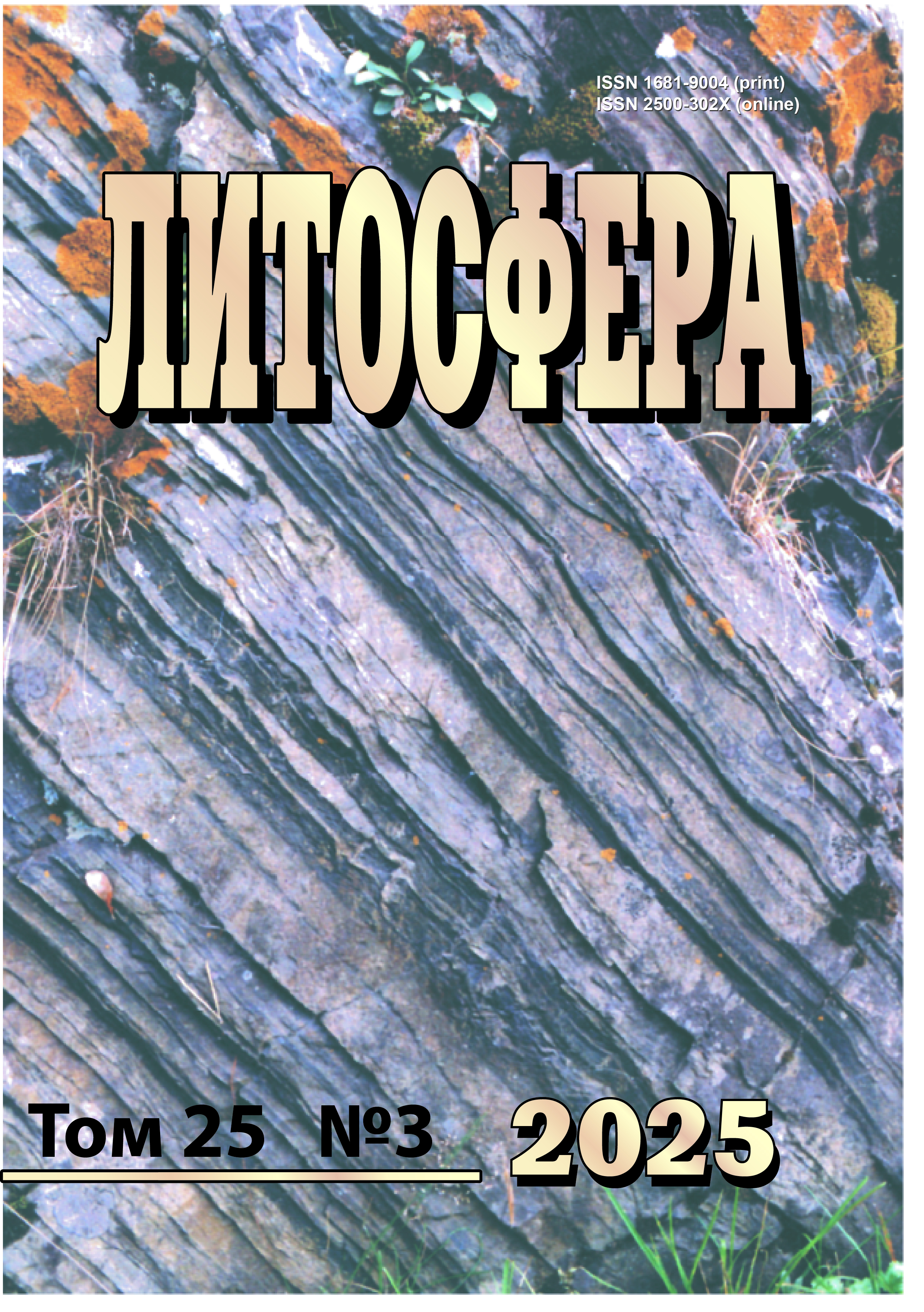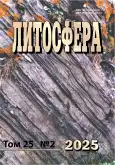High-temperature impedance spectroscopy as a technique for monitoring the initial stages of phase transformations in minerals (exemplified by almandine from the Verkholovskaya garnet mine, Middle Urals)
- Authors: Zhelunitsyn I.A.1, Mikhaylovskaya Z.A.1,2, Votyakov S.L.2
-
Affiliations:
- A.N. Zavaritsky Institute of Geology and Geochemistry, UB RAS
- Ural Federal University named after the First President of Russia B.N. Yeltsin
- Issue: Vol 25, No 2 (2025)
- Pages: 295-308
- Section: Articles
- URL: https://journal-vniispk.ru/1681-9004/article/view/311085
- DOI: https://doi.org/10.24930/1681-9004-2025-25-2-295-308
- EDN: https://elibrary.ru/YWMLUH
- ID: 311085
Cite item
Full Text
Abstract
About the authors
I. A. Zhelunitsyn
A.N. Zavaritsky Institute of Geology and Geochemistry, UB RAS
Email: zhelunitsyn@igg.uran.ru
Z. A. Mikhaylovskaya
A.N. Zavaritsky Institute of Geology and Geochemistry, UB RAS; Ural Federal University named after the First President of Russia B.N. Yeltsin
S. L. Votyakov
Ural Federal University named after the First President of Russia B.N. Yeltsin
References
- Бахтерев В.В., Кузнецов А.Ж. (2012) Высокотемпературная электропроводность магнетитовых руд в связи с их генезисом и минеральным составом (на примере Гороблагодатского скарново-магнетитового месторождения). Геология и геофизика, 53(2), 270-276.
- Иванова В.П., Касатов Б.К., Красавина Т.Н., Розинова Е.Л. (1974) Термический анализ минералов. Л.: Недра, 399 с.
- Ксенофонтов Д.А., Гребенев В.В., Зубкова Н.В., Пеков И.В., Кабалов Ю.К., Чуканов Н.В., Пущаровский Д.Ю., Артамонова А.А. (2018) Поведение катаплеита при нагревании и кристаллическая структура продукта его высокотемпературной трансформации – новой фазы Na6Zr3с девятичленными кольцами кремнекислородных тетраэдров. Зап. Рос. минералог. общ-ва, 147(3), 94-108. doi: 10.30695/zrmo/2018.1473.07
- Макарова И.П., Гребенев В.В., Черная Т.С., Верин И.А., Долбина В.В., Чернышов Д.Ю., Ковальчук М.В. (2013) Исследование изменений структуры монокристаллов K9H7(SO4)8·H2O при повышении температуры. Кристаллография, 58(3), 380-387.
- Новикова Н.E., Дудка А.П., Гроссман В.Г., Базаров Б.Г., Верин И.А., Гребенев В.В., Стефанович С.Ю., Базарова Ж.Г. (2018) Структура и фазовые переходы в монокристаллах Tl4.86Fe0.83Hf1.17(MoO4)6 в интервале температур 85–800 К. III Байкальский материаловедческий форум. Мат-лы Всерос. науч. конф. с междунар. участием. Улан-Удэ: Бурятский науч. центр СО РАН, 87-88.
- Ощепкова А.В., Чубаров В.М., Бычинский В.А., Канева Е.В. (2020) Физико-химическое моделирование качественного и количественного фазового состава железных руд. Журнал Сибир. Федерал. ун-та. Химия, 13(1), 65-77.
- Пархоменко Э.И. (1965) Электрические свойства горных пород. М.: Наука, 164 с.
- Пархоменко Э.И. (1984) Электрические свойства минералов и горных пород при высоких давлениях и температурах. Дисс. … докт. физ.-мат. наук. М.: Институт физики Земли им. О.Ю. Шмидта, 420 с.
- Салихов Д.Н., Беликова Г.И., Сергеева Е.В. (2001) Термодинамика равновесий рудных минералов марганца. Геол. сборник, (2), 163-167.
- Сорокин Н.И. (2009) Ионная проводимость натриевых силикатов со структурой типа ловозерита. Электрохимия, 45(8), 1011-1013.
- Aparicio C., Filip J., Skogby H., Marusak Z., Mashlan M., Zboril R. (2012) Thermal behavior of almandine at temperatures up to 1,200 °С in hydrogen. Phys. Chem. Minerals, 39, 311-318. doi: 10.1007/s00269-012-0488-x
- Barkova K., Mashlan M., Zboril R., Martinec P., Kula P. (2001) Thermal decomposition of almandine garnet: Mössbauer study. Czech. J. Phys., 51(7), 749-754. doi: 10.1023/A:1017618420189
- Burns R.G. (1993) Mineralogical applications of crystal field theory (2nd Ed). Cambridge: Cambridge University Press, 551 p. doi: 10.1017/CBO9780511524899
- Dai L., Li H., Hu H., Jiang J., Hui K., Shan S. (2013) Electrical conductivity of Alm82Py15Grs3 almandine-rich garnet determined by impedance spectroscopy at high temperatures and high pressures. Tectonophysics, 608, 1086-1093. doi: 10.1016/j.tecto.2013.07.004
- Dai L., Hu H., Jiang J., Sun W., Li H., Wang M., Vallianatos F., Saltas V. (2020) An overview of the experimental studies on the electrical conductivity of major minerals in the upper mantle and transition zone. Materials, 13(2), 408. doi: 10.3390/ma13020408
- Fullea J. (2017) On joint modelling of electrical conductivity and other geophysical and petrological observables to infer the structure of the lithosphere and underlying upper mantle. Surv. Geophys, 38, 963-1004. doi: 10.1007/s10712-017-9432-4
- Gardner R.F.G., Sweett F., Tanner D.W. (1963). The electrical properties of alpha ferric oxide–I. J. Phys. Chem. Solids, 24(10), 1175-1181. doi: 10.1016/0022-3697(63)90234-8
- Gavarri J. (1999) Transport properties and percolation in two-phase composites. Solid State Ion., 117(1-2), 75-85. doi: 10.1016/S0167-2738(98)00250-1
- Glover P.W.J. (2015) Geophysical properties of the near surface Earth: Electrical properties. Treat. Geophys. (2nd Ed), 11. Amsterdam: Elsevier, 89-137. doi: 10.1016/B978-0-444-53802-4.00189-5
- Gellings P.J. (2019) Handbook of solid state electrochemistry (1st Ed). Boca Raton: CRC Press, 644 p.
- Huebner J.S., Dillenburg R.G. (1995) Impedance spectra of hot, dry, silicate minerals and rock: Qualitative interpretation of spectra. Amer. Miner., 80(1), 46-64. doi: 10.1016/10.2138/am-1995-1-206
- Irvine J.T.S., Sinclair D.C., West A.R. (1990) Electroceramics: Characterization by impedance spectroscopy. Adv. Mater., 2(3), 132-138. doi: 10.1002/adma.19900020304
- Izawa M.R.M., Cloutis E.A., Rhind T., Mertzman S.A., Poitras J., Applin D.M. Mann P. (2018) Spectral reflectance (0.35–2.5 µm) properties of garnets: Implications for remote sensing detection and characterization. Icarus, 300, 392-410. doi: 10.1016/j.icarus.2017.09.005
- Karato S., Duojun W. (2013) Electrical conductivity of minerals and rocks. Phys. Chem. Deep Earth. U. S.: John Wiley & Sons, 145-182.
- Keppler H., McCammon C.A. (1996) Crystal field and charge transfer spectrum of (Mg, Fe)SiO3 majorite. Phys. Chem. Minerals, 23, 94-98. doi: 10.1007/BF00202304
- Kubelka P., Munk F. (1931) Ein Beitrag zur Optik derFarbanstriche. Z. Tech. Phys., 12, 593-601.
- Lassoued A., Dkhil B., Gadri A., Ammar S. (2017) Control of the shape and size of iron oxide (α-Fe2O3) nanoparticles synthesized through the chemical precipitation method. Res. Phys., 7, 3007-3015. doi: 10.1016/j.rinp.2017.07.066
- Lastovickova M. (1982) Temperature-time dependence of the electrical conductivity of garnets. Studia Geoph. et Geod., 26, 405-412. doi: 10.1016/B978-0-444-99662-6.50072-1
- Manning P.G. (1967) The optical absorption spectra of some andradites and the identification of the 6A1→4A1 4E(G) transition in octahedrally bonded Fe3+. Can. J. Earth Sci., 4(6), 1039-1047. doi: 10.1139/e67-070
- Mizuno S., Yao H. (2021) On the electronic transitions of α-Fe2O3 hematite nanoparticles with different size and morphology: Analysis by simultaneous deconvolution of UV–vis absorption and MCD spectra. J. Magn. Magn. Mater., 517, 167389. doi: 10.1016/j.jmmm.2020.167389
- Morales A.E., Mora E.S., Pal U. (2007) Use of diffuse reflectance spectroscopy for optical characterization of un-supported nanostructures. Rev. Mex. Fis., 53(5), 18-22.
- Naif S., Selway K., Murphy B.S., Egbert G., Pommier A. (2021) Electrical conductivity of the lithosphere-asthenosphere system. Phys. Earth Planet. Int., 313, 106661. doi: 10.1016/j.pepi.2021.106661
- Nan C.-W., Shen Y., Ma J. (2010) Physical Properties of Composites Near Percolation. Annu. Rev. Mater. Res., 40(1), 131-151. doi: 10.1146/annurev-matsci-070909-104529
- Roberts J.J., Tyburczy J.A. (1993) Impedance spectroscopy of single and polycrystalline olivine: Evidence for grain boundary transport. Phys. Chem. Minerals, 20, 19-26. doi: 10.1007/BF00202246
- Romano C., Poe B.T., Kreidie N., McCammon C.A. (2006) Electrical conductivities of pyrope-almandine garnets up to 19 GPa and 1700 °C. Amer. Miner., 91(8-9), 1371-1377. doi: 10.2138/am.2006.1983
- Sun W., Dai L., Li H., Hu H., Jiang J., Liu C. (2019) Experimental study on the electrical properties of carbonaceous slate: A special natural rock with unusually high conductivity at high temperatures and pressures. High Temperatures-High Pressures, 48, 439-454. doi: 10.32908/hthp.v48.749
- Taran M.N., Dyar M.D., Matsyuk S.S. (2007) Optical absorption study of natural garnets of almandine-skiagite composition showing intervalence Fe2+ + Fe3+ → Fe3+ + Fe2+ charge-transfer transition. Amer. Miner., 92(5-6), 753-760. doi: 10.2138/am.2007.2163
- Torrent J., Vidal B. (2002) Diffuse Reflectance Spectroscopy of Iron Oxides. Encyclopedia of surface and colloid science, 1. NY-Basel: Marcel Dekker Inc., 1438-1446.
- Townsend T.K., Sabio E.M., Browning N.D., Osterloh F.E. (2011) Photocatalytic water oxidation with suspended alpha-Fe2O3 particles-effects of nanoscaling. Energy Environ. Sci., 4(10), 4270-4275. doi: 10.1039/C1EE02110A
- Wheatstone C. (1843) XIII The Bakerian lecture. An account of several new instruments and processes for determining the constants of a voltaic circuit. Phil. Trans. R. Soc., 133, 303-327. doi: 10.1098/rstl.1843.0014
- Yoshino T. (2019) Electrical properties of rocks. Encyclopedia of Solid Earth Geophysics. Cham: Springer, 1-7. doi: 10.1007/978-3-030-10475-7_45-1
- Zhang L. (2017) A review of recent developments in the study of regional lithospheric electrical structure of the Asian continent. Surv. Geophys., 38, 1043-1096. doi: 10.1007/s10712-017-9424-4
Supplementary files









